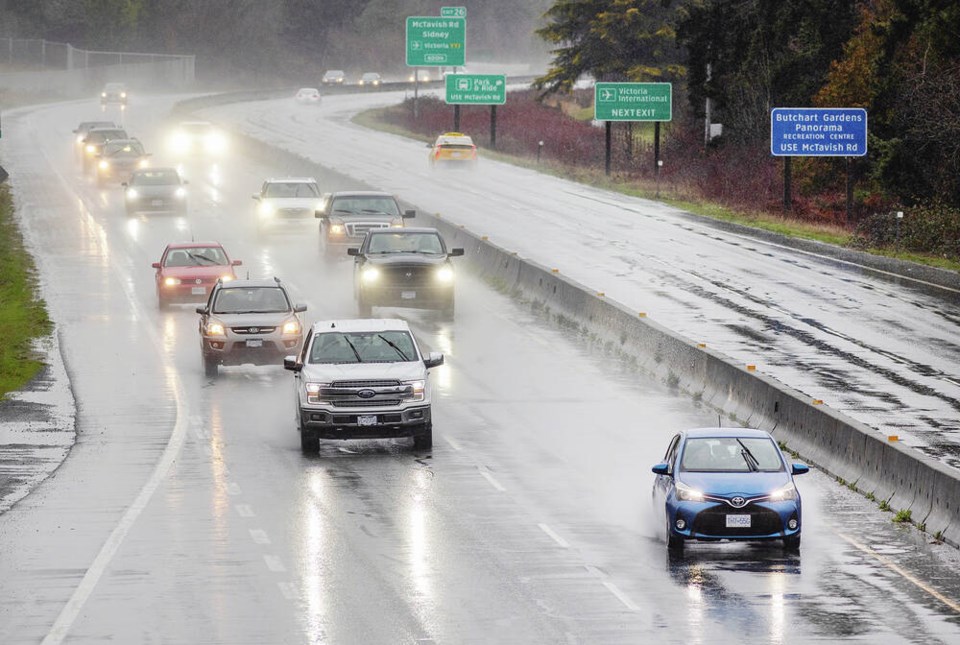Last week there was a spate of collisions tying up major roads all over the Island. Each one of them had their own unique circumstances, but I couldn’t help thinking that the heavy dose of rain that also hit us during that time might have had something to do with it.
Every driver, with even a minor amount of experience, understands that rainy, wet conditions make driving more difficult. Hydroplaning, road spray and avoiding potholes are all part of the wet weather challenge out there. But there’s a particular moment when driving in the wet that needs particular attention — navigating roads that are suddenly washed by rain after a long dry spell.
North America wide, newly wet roads create significantly more fatalities than roads that have been rained on for sustained periods. We’ve all seen the effects, those round rainbow splotches spread out all over the asphalt at the start of our springtime showers. Professional drivers and any driving instructors worth their salt have understood this problem for years.
During dry periods, fluids leak from vehicles. It can be oil or gas from leaking engines or antifreeze from a radiator in disrepair. These leaks plop out all over the road, increasing every day, spread by the sheer number of vehicles passing by. Sand and other forms of grit are also dropped to the pavement from under vehicles.
When rain finally arrives it becomes a matter of physics — oil and water don’t mix. That means that when those first sprinkles hit the pavement, oils and other fluids rise up creating a slippery smooth layer of thin goo between your tires and the road surface. The ability to stop during these times is affected dramatically.
A study for Science Daily in the early 2000s that analyzed over a million vehicle collisions confirmed what professionals have always known — newly wet streets can be treacherous.
Daniel Eisenberg, a postdoctoral scholar and author of the study, was able to show that, “…if it rains a centimetre today, on average, there will be no increased risk of fatal crashes if it also rained yesterday … but if it’s been two days since the last rain, then the risk for a deadly accident increases by 3.7 per cent. If you take it out even further to 21 days, the risk increases to 9.2 per cent, or about two and a half times more risk than if it only rained two days before.”
The number of collisions throughout the Island last week tell me that some drivers are not doing enough to adapt to changing conditions — particularly during rainy periods right after a dry spell. Weather has a significant effect on the operation of your vehicle and driving exactly the same way you would drive when roads are clear and dry doesn’t cut it.
Professional drivers tell us that the first method to deal with this problem is to brake earlier and with less pressure on the brake pedal. Wet brakes can grab, causing a wheel lockup, which can force your vehicle into a skid.
Slow steady pressure during braking not only helps to dry the brakes a little, making for better stopping power, but also alerts the driver behind you that you are intending to slow or stop. Rear-end collisions are the number one type of crash on wet or slippery roads. Right after that first rain it’s good practice to at least double the distance between yourself and the car in front.
Vehicle equipment is also important. Bald tires, no washer fluid or worn out wipers rob a driver of the time and manoeuvrability they need on oily slick streets in order to stop in time to avoid a crash.
Using cruise control on the highway during these first rain moments is also an absolute no-no. Slowing down and keeping distance are the two most important rules on newly moistened roads.
Glove Box: Distracted driving is not always about texting someone or checking out the latest dance moves on Tik-Tok. Last month a man driving on highway 3 near Trail managed to plow his vehicle into a concrete barrier because he was reaching for a piece of fried chicken. Finger lickin’ bad I’d say. I hope he enjoyed the meal as he was also driving without insurance. The extra $598 fine, laid on him by the Mounties, made that one expensive snack pack.
But you’re truly distracted when you’re so deep into your phone call while behind the wheel that you don’t notice the cop car behind you with lights and siren, blaring for over 15 seconds. That call, made by a driver in North 91原创 recently, wasn’t a cheap one either — meriting a $398 fine and 4 demerit points.



